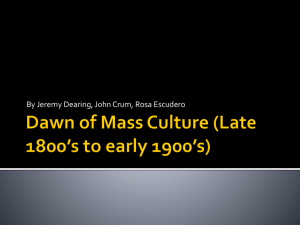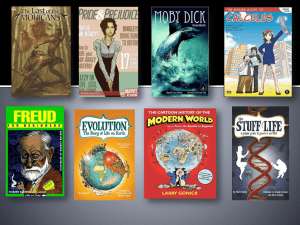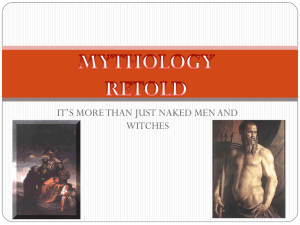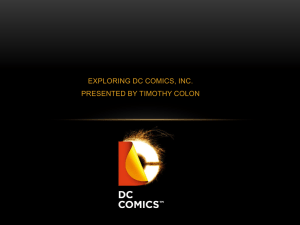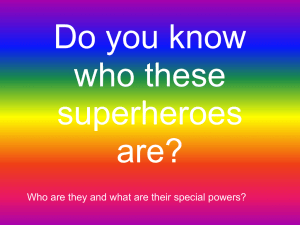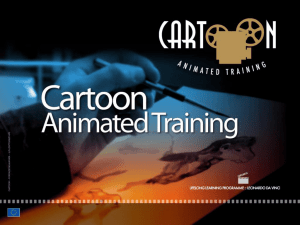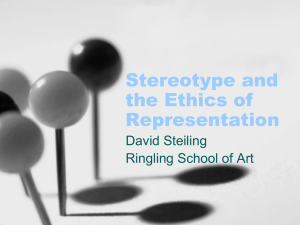585_week14 - School of Communication and Information
advertisement
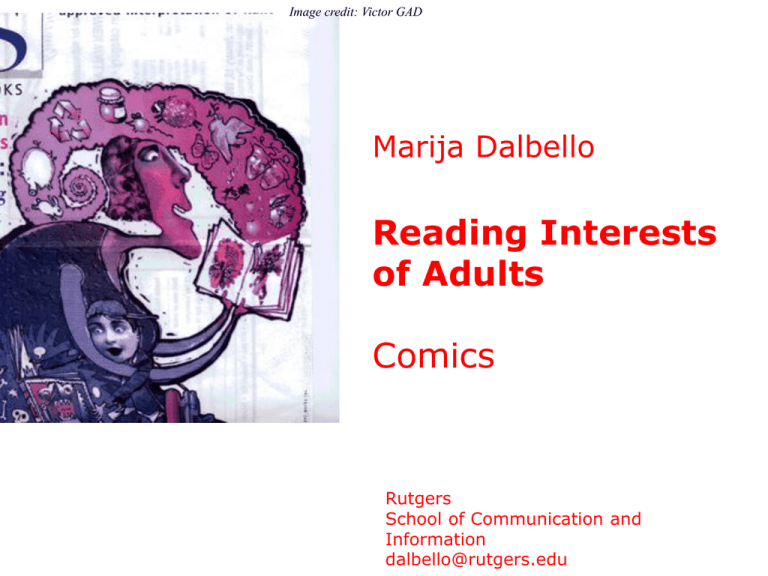
Image credit: Victor GAD
Marija Dalbello
Reading Interests
of Adults
Comics
Rutgers
School of Communication and
Information
dalbello@rutgers.edu
Overview
_______________________________________
Introduction
What is comics art?
Visual language of comics
Artists, readers and taxonomies
Conclusion
What is comics art
Definition
_______________________________________
Comics denotes a graphic medium in which
images are used to convey a sequential narrative, an
inextricable mixing of words and pictures arranged
in a deliberate sequence, intended to convey
information, amuse, or provoke laughter
What is comics art
Comics culture
_______________________________________
Scott McCloud, Understanding Comics (1994)
What is comics art?
_______________________________________
Eclectic visual forms, genres, and formats are all included
Comics / Comix
Graphic novels
Cartoon strip
Manga
Themes and types vary - and proliferate ever more
Superhero comics
Science fiction
Western
Fantasy
Horror
Mainstream and alternative comics
Transmedia phenomenon
What is comics art
Tradition
_______________________________________
From pictorial storytelling to superhero comics - and beyond
European tradition
American tradition
Development of visual forms in comics art has a complex history
Connection to film, cartoons
Popularized in newspapers and magazines - late 1890s
Origin in narrative illustration
Comics art and comics have a social history too
Comic book code defines industry
Debates about comics literacy
Corruption of the innocent?
Adult comics of the 1960s, slump in the 1980s, revival in the
1990s (alternative comics), the graphic novels boom
Narrative illustration - example
From: http://thelittlechimpsociety.com/onehugeeye/cheltenham-illustration-awards/
What is comics art
Tradition
_______________________________________
From pictorial storytelling to superhero comics - and beyond
European tradition
American tradition
Development of visual forms in comics art has a complex history
Connection to film, cartoons
Popularized in newspapers and magazines - late 1890s
Origin in narrative illustration
Comics art and comics have a social history too
Comic Book Code defines industry
Debates about comics literacy
Corruption of the innocent?
Adult comics of the 1960s, slump in the 1980s, revival in the
1990s (alternative comics), the graphic novels boom
Qui ckTime™ and a
decompressor
are needed to see this pictur e.
Visual language of comics
_______________________________________
QuickTime™ and a
decompressor
are needed to see this picture.
Fundamental elements of comics literacy
Scott McCloud’s {Understanding, Reinventing} Comics
Visual iconography and established visual vocabulary
Narrative closure - constructing a continuous unified reality
Color
Panel layout
Self-reflexivity
Deliberate breaking of rules
Visual conventions (balloons and types of speech, mood)
Arrangement of panels, size of panels, reading directions
Convention and innovation
Avant-garde authors, artists, illustrators
Visual language of comics
Comics literacy
_______________________________________
A system of meanings, a language
Symbolism, convention, horizons for reading involved
Creating meaningful differences among pictures through
“sequential art”
Panel-to-panel transition most common (Puszt, pp. 115-120)
Numbering
Arrows to show transitions
Traditional left-to-right reading direction
Matrix instead of sequence, unified panel, alternative and
experimental comics
Visual language of comics: comics literacy
Panel-to-Panel transition
_______________________________________
Action-to-action transitions
Single subject in a brief sequence of movement or change
(character swinging a fist)
Subject-to-subject transitions
Focuses on a single scene or idea but moves its focus from place to
place during the sequence (showing anguished face of characters in
the same scene)
Scene-to-scene transitions
Deductive reasoning involved - reader fills in the gaps of time and
space between the panels; separation of specific sequences; time
and space changes
Aspect-to-aspect transitions
Montage of elements reflecting a single place, idea, or mood
Non sequitur transitions
No logical relationship between panels but they can create
“meaning or resonance”
FIND EXAMPLES IN YOUR READING
QuickTime™ and a
decompressor
are needed to see this picture.
Pictures as part of a sequence “transforms the art of the
images into something more: the art of comics!” (Scott McCloud)
Visual language of comics: comics literacy
Matrix instead of sequence
_______________________________________
Unified panel
Multiple directions
Hypertextual storyspace
Avant-garde and experimental
Chris Ware
Alternative comics
What is comics art
Comics lifecycle
_______________________________________
Artists
Mainstream
Avant-garde
Publishers
Mainstream (DC
comics, Marvel)
Independent
(minicomics)
“samizdat”
Alternative
Fringe
(Chick tracts)
Readers
Adults
Adolescents
Artists and Writers
_______________________________________
Robert Crumb
Harvey Pekar
American Splendor
Daniel Clowes
Ghost World
Art Spiegelman
Mauss
Mirjam Satrapi
Persepolis
Alan Moore and Dave Gibbons
Watchmen (cinematic effects)
Neil Gaiman
Death, The Cost of Living, Sandman (horror, supernatural)
Readers
_______________________________________
Extensive reading
Collecting (“fanboys” and “true believers”)
Reading within a niche culture, in-crowd
Close relationship with production
Readers as participants and producers in the culture
Interaction between readers and writers (published letters)
Audience: mainstream and alternative
Male readership: superhero comics, connection to adolescence
Female readership: alternative comics, manga
Comic book culture: Comicon, specialized bookstores
Taxonomies
_______________________________________
Manga (anime)
Superhero comics (young adult, adult)
Alternative comics (adult)
Indie comics
Genres: action (power fantasy), romance, horror,
supernatural, erotica, SF
The cover artwork for an issue of Zap Comix,
featuring the character Mr. Natural.
The cover artwork for an issue of Zap
Comix, featuring the character Mr.
Natural.
Conclusion
_______________________________________
Narrative medium consisting of juxtaposed text-image systems
Comics are mass culture form as well as ancient graphic art
Nostalgia space for readers, reminiscent of adolescence
Visual narratives tied to a range of popular genres
A “low” art form or sophisticated form of literacy?
Multiculture, art, literature, critique
